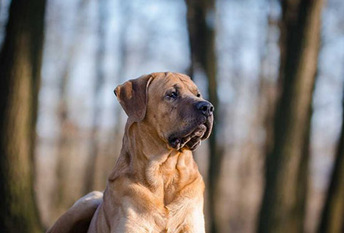The Boxer is an easy-care dog. His short, smooth coat benefits from weekly brushing with a firm bristle brush or rubber curry brush to keep it shiny and healthy and to remove dead hairs that would otherwise find their way to your clothes and furniture.
Frequent baths are not necessary unless he gets dirty, but with the gentle dog shampoos available now, you can bathe a Boxer weekly if you want without harming his coat.
Clean the ears as needed with a solution recommended by your veterinarian. Don’t use cotton swabs inside the ear; they can push gunk further down into it. Wipe out the ear with a cotton ball, never going deeper than the first knuckle of your finger.
Trim the nails every couple of weeks or as needed. Don’t let them get so long that you can hear them clicking on the floor.
Boxers are very playful, high-energy dogs. They need ampleexerciseevery day, on a leash or in a securely fenced area.
The Boxer must never be allowed to run loose. They spend a good deal of time jumping and leaping about—as young dogs, they are constantly in need of reminders to teach them to stay “down.” Because the Boxer is a powerful, active, and playful dog, he may not be the best choice for a very frail adult, nor for a small child who could be overwhelmed by a well-meaning but bouncy puppy.
Monitor your Boxer’s diet as the breed suffers from allergies and metabolic problems. You may find that giving your Boxer several smaller feedings throughout the day works best.
The average life span of the Boxer is 11 to 14 years. They are not particularly well-suited to living in climates with temperature extremes.
Breed health concerns may includeallergies,bloat, Boxer cardiomyopathy, sick sinus syndrome, pododermatitis (especially on the front feet), canine follicular dysplasia, brachycephalic syndrome, ear infections, epilepsy,hip dysplasia,hypothyroidism, insulinoma, pyloric stenosis, histiocytic colitis, congenital elbow luxation,melanoma, cutaneous histiocytoma, sensory neuropathy of Boxers,entropion,ectropion,“cherry eye”,corneal ulceration, cryptorchidism,sarcomasand subaortic stenosis.
Boxers are particularly predisposed to having adverse drug reactions to even small doses of Acepromazine and other phenothiazines.
Since Boxers are always in motion, sometimes training can be difficult. Like other large dog breeds, Boxers need to be trained using consistently and patiently, as this dog doesn’t respond well to harsh treatment. To make things easier in the beginning stages of the training process, try to make it simple for your Boxer – this will help build the dog’s confidence in order to move onto difficult challenges.
It’s a good idea to use rewards, as they are effective to use when training your boxer. One aspect you’ll find easy, in regards to training, is housebreaking. Because the Boxer’s natural inclination to be clean, housebreaking tends to be the easiest process of training.













